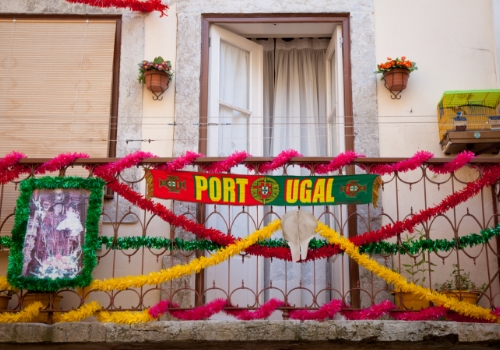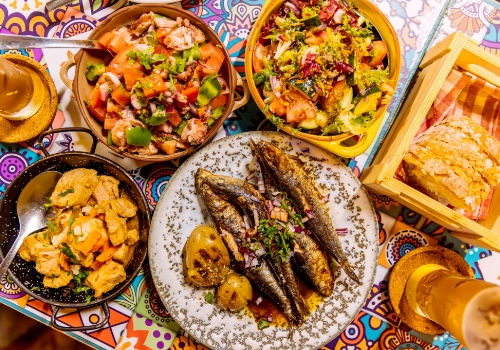Guerin® Blog
Explore the best destinations: Guerin
Lisbon’s Santo António: A Must-See Guide to the City's Popular Festivities.
Share
The festivities in honour of Santo António of Lisbon take place throughout June, with the main event on the night of the 12th into the 13th. Known as Santo António’s Eve, this night is when the city truly comes alive.
Let yourself be swept up in the joy, music, the unmistakable scent of grilled sardines, and the colourful decorations – this guide will take you through the best of Lisbon’s most beloved traditional festival.
Typical Neighbourhoods of Santo António in Lisbon.
Some of Lisbon’s most iconic neighbourhoods burst into life during the month of Santo António. You’ll find everything from food stalls to music, but folk tunes and dancing are truly the soul of the celebrations. Discover the top spots across the city.
Alfama.
Alfama is the beating heart of the festivities. With its narrow streets, rich traditions, and vibrant atmosphere, it’s the oldest and most charismatic neighbourhood in Lisbon. Here, the sound of fado floats out of open windows, and wandering its alleys is part of the charm.
Street parties, or arraiais, pop up on every corner with makeshift stages, portuguese folk music, dancing, and traditional food stalls.
Don’t miss Largo de São Miguel and Rua dos Remédios – key spots for the most authentic Santo António experience.
What to Visit in Alfama.
Take in the views from Santa Luzia viewpoint, and visit iconic landmarks such as Lisbon Cathedral and the National Pantheon.
By day, explore craft shops and the Fado Museum. By night, Alfama transforms into a festival hotspot with street parties and fado houses offering dinner and traditional music.
Where to Eat in Alfama.
Looking for authentic Portuguese food during the celebrations? Try these local favourites:
- Parreirinha de Alfama
- Casa da Tia Helena
- Mesa de Frades
Must-Visit Alfama Street Parties.
- São Miguel Street Party – traditional and family-friendly.
- Grupo Sportivo Adicense Party – live music and communal tables.

Mouraria.
The birthplace of Lisbon fado and home to many iconic fadistas, Mouraria is known for its multicultural flair, with communities from around the world living side by side.
What to Visit in Mouraria.
Wander its narrow streets and discover urban murals like the famous São Cristóvão stairs, and visit cultural spots like the Mouraria Innovation Centre. Explore São Cristóvão Church and browse through local shops.
By night, enjoy the intimate atmosphere of small bars and hidden fado houses. This is Lisbon at its most authentic.
Where to Eat in Mouraria.
Don’t miss the chance to savour local dishes in these typical restaurants:
- Zé da Mouraria.
- O Trigueirinho.
- Taberna Da Mouraria.
Santo António in Mouraria.
Key locations like Largo da Achada, Largo dos Trigueiros, and the São Cristóvão stairs become festive hotspots during the Santo António celebrations.
Graça.
Breathtaking views and a welcoming, family atmosphere – that’s Graça in a nutshell. One of Lisbon’s most charming areas, it’s nestled among the city’s most scenic viewpoints.
What to Visit in Graça.
Set atop one of Lisbon’s hills, it’s home to iconic viewpoints like:
- Senhora do Monte Viewpoint – perfect for sunset
- Graça Viewpoint – with cosy seating and views over the Castle of São Jorge
You’ll also find traditional grocers, art galleries, and local markets.
Where to Eat in Graça.
To relax and enjoy a bite, try:
- O Satélite
- O Pitéu da Graça
- Penalva da Graça
Popular Saints Celebrations in Graça.
During the festival, Graça becomes even livelier with street parties and a strong sense of community. The Vila Berta Arraial is among the most iconic, drawing large crowds with food stalls, live music, and dancing into the early hours.



Bica.
Famous for its funicular and lively Santo António celebrations that last well into the night, Bica is one of Lisbon’s most picturesque and energetic neighbourhoods, with steep streets and buzzing nightlife.
What to Visit in Bica.
The iconic Rua da Bica de Duarte Belo, flanked by colourful houses and overlooking the Tagus, is one of the city’s most photographed streets.
Explore the stairways, hidden cafés and galleries, and visit Santa Catarina Viewpoint, a great place to unwind to the sound of street musicians.
At night, Bica becomes a nightlife hotspot with lively bars and terraces.
Where to Eat in Bica.
For food, try:
- Bica do Sapato.
- Time Out Market.
Popular Saints in Bica.
The Bica Arraial, on Rua da Bica de Duarte Belo, becomes a festive corridor filled with lights, food stalls, and open-air bars. Expect DJs and folk bands keeping the party going all night.
Santo António Traditions: music, dance, and more.
June arrives in Lisbon with the scent of basil, grilled sardines, and the vibrant sound of arraiais filling the city’s neighbourhoods. At the heart of it all is Santo António, known as the matchmaker saint, whose celebration is much more than a religious devotion – it’s a spectacle of tradition and community.
Between parades, music, and dances passed down through generations, Lisbon becomes a stage where everyone is welcome to join in.
Popular Marches.
On the night of 12 June, Avenida da Liberdade bursts with colour as neighbourhood parades take over. Expect elaborate choreography, upbeat music celebrating each district’s pride, and themed traditional costumes.
Santo António Weddings.
A unique Lisbon tradition – several couples get married in a single ceremony supported by the city council. It’s a touching and symbolic moment that embodies the spirit of the Santo António celebrations.

What to Eat During the Popular Saints Festivals?
Food is as much a part of the Santo António festivities as the music and decorations.
- Grilled Sardines: served on bread or with potatoes and salad, the smell of sardines grilling in the streets is iconic.
- Chouriço Bread: simple and flavourful, perfect for eating while dancing.
- Caldo Verde: Portugal’s classic kale and chouriço soup.
- Grilled Meats: pork belly and pork steaks, served in bread or with fries – a great alternative to sardines.
Traditional Snacks.
- Snails (Caracóis) – a Lisbon favourite
- Roasted pepper salad
- Seasoned olives
- Cured cheese with bread
Typical Desserts.
- Santo António Cake
- Rice pudding
- Fried dough pastries (Filhós or Farturas) with cinnamon sugar
Drinks to Enjoy.
- Ice-cold beer
- Sangria
- Red or white wine
- Ginjinha (sour cherry liqueur)
12 June Itinerary: the essence of Santo António Festival.
If you only have one night to experience the celebrations, here’s the perfect itinerary:
- 18:00 – Arrive in Lisbon and park outside the centre. Take the metro-to Baixa.
- 18:30 – Dinner in Alfama: grilled sardines and caldo verde.
- 20:30 – Head to Graça to watch the sunset at Senhora do Monte Viewpoint.
- 21:00 – Walk to Avenida da Liberdade for the Popular Marches.
- 23:00 – Head to Mouraria for dancing and live fado.
- 01:00 – End the night in Bica with music and street parties until dawn.
Drive with Guerin's flexibility.
Book with Guerin and enjoy the Santo António celebrations with total freedom. If you're coming from outside Lisbon, rent a car and park on the outskirts (Entrecampos, Sete Rios, Chelas or Benfica), then take the metro-to the city centre – it’s quicker, cheaper, and stress-free.
Lisbon is waiting – and with Guerin’s pioneering 100% digital booking process, you can hit the road in just 9 minutes. From booking to key collection, it’s fast, autonomous, and seamless. Celebrate Santo António 2025 with us!


Share

